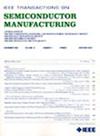Comprehensive Study of the Impact of LWR on Device Performance in VLSI Technology
IF 2.3
3区 工程技术
Q2 ENGINEERING, ELECTRICAL & ELECTRONIC
引用次数: 0
Abstract
Line Width Roughness (LWR) has emerged as a pivotal challenge that the semiconductor manufacturing industry must confront. This study provides experimental data to elucidate the mechanism by which LWR affects device performance in different processing layers. First, Hard Mask (HM) technology was used to reduce LWR of Active Area (AA) and polysilicon gate by 0.97 nm and 0.62 nm, respectively, resulting in a 21.79% and 55.82% decrease in threshold voltage variability. With the application of HM technology in AA layer processing, the device performance of NMOS and PMOS was also improved by 19.58% and 12.54%, respectively. This improvement can be attributed to the mitigation of carrier scattering induced by LWR. Moreover, HM technology was also conducted in polysilicon gate process which can reduce LWR effectively, thereby enhancing device stability, decreasing the drain-induced barrier lowering factor by approximately 10%, and suppressing gate-induced drain leakage current and overlap capacitance. Consequently, this process contributes to the alleviation of short channel effects. Our research provides experimental groundwork for diminishing LWR, supplies guidelines for understanding the distinct mechanisms of LWR, and offers effective route toward enhancing device performance, and controlling fluctuations.LWR对VLSI技术中器件性能影响的综合研究
线宽粗糙度(LWR)已成为半导体制造行业必须面对的关键挑战。本研究提供了实验数据来阐明LWR在不同处理层影响器件性能的机制。首先,采用硬掩膜(HM)技术将有源区(AA)和多晶硅栅极的LWR分别降低了0.97 nm和0.62 nm,使阈值电压变异性降低了21.79%和55.82%。将HM技术应用于AA层加工后,NMOS和PMOS的器件性能也分别提高了19.58%和12.54%。这种改善可归因于低比比引起的载流子散射的缓解。此外,在多晶硅栅极工艺中也进行了HM技术,可以有效地降低LWR,从而提高器件的稳定性,使漏极势垒降低因子降低约10%,并抑制栅极漏极漏电流和重叠电容。因此,这一过程有助于减轻短通道效应。我们的研究为减小LWR提供了实验基础,为理解LWR的不同机制提供了指导,并为提高器件性能和控制波动提供了有效途径。
本文章由计算机程序翻译,如有差异,请以英文原文为准。
求助全文
约1分钟内获得全文
求助全文
来源期刊

IEEE Transactions on Semiconductor Manufacturing
工程技术-工程:电子与电气
CiteScore
5.20
自引率
11.10%
发文量
101
审稿时长
3.3 months
期刊介绍:
The IEEE Transactions on Semiconductor Manufacturing addresses the challenging problems of manufacturing complex microelectronic components, especially very large scale integrated circuits (VLSI). Manufacturing these products requires precision micropatterning, precise control of materials properties, ultraclean work environments, and complex interactions of chemical, physical, electrical and mechanical processes.
 求助内容:
求助内容: 应助结果提醒方式:
应助结果提醒方式:


